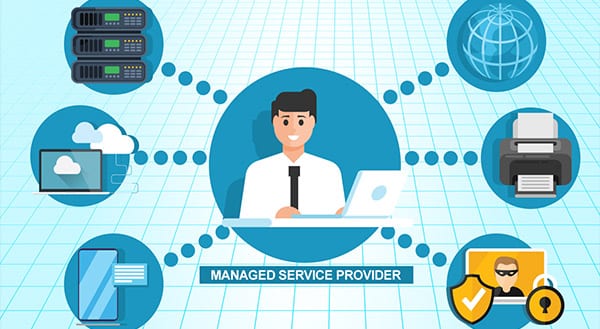
Whether you’re working with a marketing firm, an HVAC company, or a managed services provider (MSP), you want to make sure they know what they’re doing, and that your assets are in good hands. [Read more…]

Whether you’re working with a marketing firm, an HVAC company, or a managed services provider (MSP), you want to make sure they know what they’re doing, and that your assets are in good hands. [Read more…]

You’re connected to cloud storage and file sharing, so you should be good to go having all your files backed up, right? Wrong! [Read more…]

Every business needs to have a business continuity and disaster recovery plan in place, or else risk losing everything in the event of an unexpected crisis. [Read more…]

Technology is the lifeblood of business today, and you likely have a lot of it. But you may have accumulated software and hardware as you grew. Now, you have a hodgepodge of technologies never designed to work together. Consolidation can help.
Large corporations can afford an in-house IT team to keep track of all the hardware and software, but small- to medium-sized businesses often need help. Managing computers and mobile devices, and telephony print and fax systems can be overwhelming. Then, there’s all the software you need to secure, not to mention setting up data recovery in case of a disaster or emergency.
Consolidating your technology offers several benefits to companies of all sizes. A managed service provider can help.
#1 Increased Efficiency
If there’s a problem with your printers, phones, or Internet connection, you call your provider. When many vendors offer each of these services, you make several calls, which means waiting on the phone with a printer tech, phone company, or internet service provider (ISP).
When you connect with customer support, they can address only issues in one area of concern. The ISP isn’t going to know anything about your phone service, and the phone company knows zilch about printers. This disjointedness can waste a lot of time.
With an MSP, you need to make one call only. The support person will know and understand your entire system. They offer input based on how different technology interacts.
#2 Cost Savings
Lacking a holistic view of your technology and its interactions, you can end up wasting money. You might invest in a new feature for voice over IP, duplicating a capability you already have online.
Consolidating your technology with a single provider can also streamline costs. The first thing an MSP will do is to map out how your technology works together. Armed with an understanding of business needs and goals, they’ll make recommendations. You may be able to cut back on services in one area with a simple upgrade in another. Perhaps you’re paying for software licenses you no longer need. Plus, the MSP identifies opportunities for cost savings gained from bundling services.
The MSP typically charges a monthly, consolidated fee. Instead of managing several bills for every technology, you pay a single, consistent fee, which also makes budgeting much easier.
#3 Business Agility
If 2020 has taught us anything, it’s that business needs to be nimble. Yet your ability to react can be slower working with many different vendors. Simplifying your processes can streamline your response times.
An MSP will take a proactive approach to oversee your technology needs. They want you to avoid disruptions in the first place. Partner with an MSP to keep technology current, security up to date, and systems upgraded. This frees up what IT staff you have on-site to do more business- and revenue-generating work.
#4 Supportive Partner
Individual vendors focus on selling you their particular services or systems. The overall interplay of your technology isn’t their primary concern. Yet ensuring all your technology interacts effectively and efficiently is what the MSP does best.
Working with an MSP you gain a business partner that cares about your success. The MSP’s job is to determine whether:
An MSP offers a single point of contact. That contact will understand your entire setup and how it works together. The MSP will help you make better purchasing decisions. Plus, as a true business partner, an MSP supports your agility and success. Find out more about what we can do for you today!

You’ve decided to buy a new computer for your business, perhaps even a whole set of computers. You can almost taste the excitement as you think about those sleek new machines and how much faster your employees will be able to do their work. There’s just one thing left to do: actually, choose which ones. That’s where it gets tricky. Most people pop out to their local retail store and look at the display models, then get overwhelmed when the salesperson starts throwing words like CPU and RAM around. Unfortunately, that scenario almost always ends up with your business having the wrong computer. Here’s why, and what you should do instead.
Most retail salespeople are minimally trained: Unsurprisingly, salespeople are trained to sell! They may have an interest in computers and they’re certainly great at reading the words on the box to you, but that’s the limit of their expertise. Their goal is to make the sale, earn the commission and go home happy. You are getting the computer your business needs and that 100% suits your purpose isn’t particularly high on their priority list. They’re not equipped to deeply understand the way your business works, nor do they have the time to find out. You’re also more likely to be upsold extras you don’t need but will rapidly drain your budget.
Compatibility can be a problem: While you probably know having both Mac and PC can lead to compatibility issues, did you know even switching brands within your PC network can cause issues? There are so many moving parts to your business network, from printers to routers, laptops to mobile payment processors, that anytime you throw a new computer into the mix you could end up with compatibility problems. Salespeople don’t know what your current setup is at your home or business but may still make recommendations based on assumptions and hopeful guesswork. Even the number and types of ports available on retail computers may cause a problem once you’re setting up.
The last thing you want to do is end up with a collection of wobbly adapter plugs as you attempt to course-correct and make do until it’s time for a do-over. Any time your employees need to go off-book and create workarounds, efficiency is guaranteed to take a dramatic hit. It’s best to skip the drama and get the right computer first time around.
Support could get tricky: Your IT provider will often stick to a handful of vendors to ensure all parts are kept uniform. That way we know which parts will work together, and should something fail, we can usually get replacements quickly. We’ll often have special relationships with parts vendors and can get special pricing, extended support, and upgrades that a salesperson can’t match. Your IT budget goes further with your consultant, and not just on the day of purchase.
By contrast, when you buy computers through your IT provider, you know you’re getting the exact computer your business needs. We know your business inside and out, including your long and short-term goals. From the first time you work with us, we’ll be sure to do our research before making a recommendation. Remember, you want your computers to last 3-4 years of heavy usage, so it’s also a good idea to buy business-grade computers. While the computers at the retail store are equally shiny, they’re rarely as durable as the ones your consultant can supply.
Your IT provider will also be able to set the new computers up, ready to go with the exact software you need. We’ll strip out all the bloatware (unnecessary programs and trials that come pre-installed) and configure your new computers to work perfectly from day 1. Your employees will be able to enjoy their new systems, take full advantage of the productivity boosts you paid for. That means the internet working, internal network connected, programs playing nice with each other, and yes, even printing without problems!
We can help with your next purchase – ask us how by calling us at 312-600-8357!

Technology is a wonderful addition to every business, but what happens when the IT goes down? All those things you do now that were completely unthinkable 30 years ago have become part of your day-to-day processes. It lets you compete with big business and connect with customers from far away, boost productivity and efficiency like never before, and even added multiple zeros to your bottom line. IT is a necessity. Unfortunately, this means when downtime inevitably hits, you’ve got a BIG problem.
Maybe it’s from a virus attack, a bug in the system, hardware failure or something else…whatever the cause, the impact is real and measurable. Gartner (an IT research company) reports that 43% of small businesses close their doors right after a major data loss, and only a tiny 6% survive long term. The financial cost of each hour can be in the thousands, and the damage to your brand could be ruinous. Fortunately, while downtime will occasionally strike every business, there are things you can do to minimize the duration and frequency.
Taking a few simple actions now may result in your business staying open while your competitor gives up.
Use monitored antivirus and firewalls
While most businesses have these protections, not all have embraced the idea of monitored antivirus and firewalls. Instead, the default setup has more in common with a home setup than a robust professional system. Given that SMBs are a primary target for malware and cyber-attack, you should seriously consider moving to the monitored versions. Our experts set up custom protection to block all attacks, both known and emerging. All updates are taken care of, plus company-wide protections applied so users can’t accidentally infect the network. When something doesn’t look quite right, our monitors take immediate action to protect your business.
Have backups you can count on
A great backup can not only protect you from digital threats like viruses and ransomware, they protect against physical threats like robbery, fire or natural disasters. The last thing you want is for your business to be crippled by data loss. A robust backup system can be as simple as asking our Managed Services team to take care of it, or if you have an on-site technician, using the rule of 3: one backup on the server, one unplugged from the server, and one off-site. If anything ever goes wrong, you’ll be able to pull up the most recent backup and continue as normal. Businesses without good backups tend to be down or limping along for days, if not weeks.
Plan for disaster
Nobody likes to think about their business flooding or being hit with ransomware, but would your employees know what to do if something happened? Having a comprehensive Disaster Recovery Plan helps you get up and running quicker, minimizing downtime. Everyone knows what steps to take, who to tell, who should be doing what, and which systems take priority.
Monitor hardware for early signs
Computer hardware is like any piece of equipment – when it’s getting old or cranky, it will let you know! This could be anything from making noises, being louder or slower than normal, or even system crashes. Each symptom is the early warning system that allows you to take action before a crash that sends everything into downtime. Our hardware monitoring service runs in the background and tracks various metrics to predict time until failure. If the signs point to imminent failure, we’ll let you know and can often repair/replace the affected hardware with little or no downtime.
Downtime is an unavoidable part of any tech-enabled business, but your preparation can dictate whether it goes for one minute or one week and how often it happens. According to one study, most firms experience 43 hours average downtime per year, a number much too high for comfort. While scheduled downtime can sometimes be unavoidable, your business will appreciate being able to skip the panic of surprise downtime events. Reducing your risk is the best action you can take, making downtime a truly rare occasion. Even better, our Managed Services can take care of this for you, stopping many downtime-events before they occur.
Talk to us about minimizing your downtime. Call us at 312-600-8357

By now you know that building up your cybersecurity is just as important as building up your cash flow. Both are essential to your success, but while most businesses keep an eye on the financials, they tend to think cybersecurity is something they can set and forget. Unfortunately, cybercriminals are constantly coming up with new methods of attack and the security you had in place yesterday may not be sufficient today.
Instead of reacting to breaches and taking on the costs of downtime, lost files, and destroyed trust, a periodic security assessment can identify blind spots that place you at risk. Once you know about these problems, you’re able to proactively set up adequate protection before cybercriminals strike. It’s best to use independent IT experts who can audit your security from an outside perspective, often seeing risks that would otherwise be missed.
Regulations change – Are you affected?
Many businesses are kept to strict government regulations around the way they store, process and protect data. Their operating license depends on staying as secure as possible. All regulations require regular security assessments but they vary in scope and timeframe. As regulations change, so do the security assessment requirements. You can imagine how much stricter they are now compared to just 5 years ago. Our team can ensure your business is meeting the relevant regulations, diving deep to be certain you’re safe.
Security patches and updates are vital
It’s so easy to fall behind on your security patches, after all, it seems like there’s a new update every week and each one takes precious time to apply. What we’re seeing though, is that cybercriminals are targeting any business running late, and it’s basically easy pickings for them. If you’re unpatched where it counts, it’s like inviting them in. When we conduct your security assessment, we take a look at your history and see if your business has a robust patch plan in place and make sure you’re up to date. If there’s an issue that’s placing you at risk now, impacted you in the past, or will in the future, we’ll find it.
Viruses are always evolving
Just like the human variety, computer viruses are nothing to welcome into your workplace. They’re constantly evolving to skip past anti-virus scans and do damage in new and interesting ways. Cybercriminals know people are more aware of the traditional infection methods like downloading an attachment or inserting an infected USB, so they’re getting more and more creative. Your security assessment doesn’t just include ticking that you have the latest anti-virus, it includes identifying where you’ve had the most breach attempts and where your biggest vulnerabilities are. This type of precise awareness has a lasting impact on reducing your risks.
Your business may have changed
As your business has grown over the years (or shorter if you’ve experienced a recent surge), your entire setup has changed. More employees, expanded remote access, additional vendors, supplementary locations…the list really is endless. With each change has come a new risk, particularly if your security has been growing around you. It might be that your password policies haven’t been updated since you began, or that you still have the old voicemail system even though phones are within easy reach of customers. This is perhaps one of the most useful areas a security assessment can help with, as you and your employees are accustomed to the business working in a certain way, whether that way leads to risk or not. Our experts will be able to see things from a different perspective, particularly as we make sure to think the same way a cybercriminal would.
What to do with your assessment results
While many experts might present you with a long list of problems and leave you feeling overwhelmed, our team ensures you have a benchmark for progress. You’ll know exactly what you need to do, how we can help, and perhaps most importantly, which actions take priority. Moving ahead, future security investments will be smarter as you focus on the high-payoff areas. You’ll also know exactly what you’ve done well and where your security strengths lie. Employees will see how much you value security, which helps to create a stable culture, and you’ll be able to report your commitment to customers, confirming they’re making the right choice by staying with you.
Book your security assessment today. Call us at 312-600-8357

It’s tempting to hire an in-house IT technician to take care of your network and set them up with a cozy office just down the hall, but is it the right decision for your business? If you’re like most businesses, you’re always on the lookout for ways to save money while improving results. Sometimes this means expanding your staff to include a team of tech specialists at your beck and call, but this can often be an unnecessary expense that leaves you with highly paid employees twiddling their thumbs all day. For SMEs who are looking for the best of both worlds, we recommend Managed IT services.
Put simply, Managed IT is our solution which gives you that team of specialist technicians and network experts, without the ‘quick, look busy’ element - and at a fraction of the cost. Naturally, you’d rather see your IT budget working to support your growth and kept as low as possible. That’s our focus too, and why we don’t simply maintain and repair your systems, we proactively monitor to avoid downtime and work with you to ensure your IT increases productivity and efficiency. Whether you already have in-house IT and are auditing the value, or are curious about what having IT support might be like for your business, we’ve put together a few factors to consider before making your choice:
Availability: Most employees work 9-5, but what happens if something goes wrong with your systems outside these hours? Your in-house technician won’t appreciate being woken at 1 am and called in for emergency repairs. It’s more likely that they simply won’t answer the call (or hear it), or if they do, expect some hefty contract renegotiation come 9 am. Managed IT is very different as we expect problems after hours and have support technicians ready. We know that every minute of downtime is affecting your revenue, plus your business reputation, so we prioritize getting your systems up and running asap. As a bonus, with our Managed IT these types of disasters are rarer as we’re constantly monitoring and correcting problems before they occur.
Total cost: One of the things that may have attracted you to have an in-house technician is the cost. But while you may be able to pay them a lower hourly rate, there are extra costs like hiring, training, ongoing training, healthcare and retirement. Once you start adding up the cost of an in-house technician, you might find it’s eating up your IT budget and leaving you scrambling to fill gaps you didn’t expect. Upgrades get delayed, opportunities missed, and IT expenses become a sore point. In comparison, Managed IT is one fixed monthly rate delivering enormous value, including access to specialists across all software applications and technology.
Ongoing Training: Putting aside the fact your technician will often spend entire weeks away upgrading their skills and leaving you scrambling for support while they’re gone, those training costs quickly add up. With a salaried technician, you’ll have to pay all ongoing training and certification costs, plus travel costs for industry conferences. We know how important it is to remain current, certified and skilled in new technologies, so we spend the money to invest in ourselves so we can serve you better. We’re part of industry related communities and attend multiple conferences each year, all at our own expense.
Different goals: For most employees, a higher wage is the goal and many will job-hop to achieve that. A salaried tech may be looking for the first opportunity to leave and get paid more, often leveraging all the training you’ve just provided. In these modern times, switching jobs regularly is expected, with an average of only 3 years in each position. Considering how much it cost your business to acquire, train and upskill your technician, 3 years is an unreasonable ROI. Our goals couldn’t be more different - we only aim to keep you a happy customer for as long as we can!
In the end, your business needs to find the right balance between profit and expertise. When you partner with our Managed IT, you’re securing availability, ever-increasing expertise and commitment to your success. We work closely with you to provide the very best support and protect you costly disasters, taking preemptive action to keep you safe and operational. There’s no doubt Managed IT is a better decision than hiring an in-house technician, and we’d be delighted to prove it to you.
Talk to us about Managed IT for your business. Click the button below for your assessment
